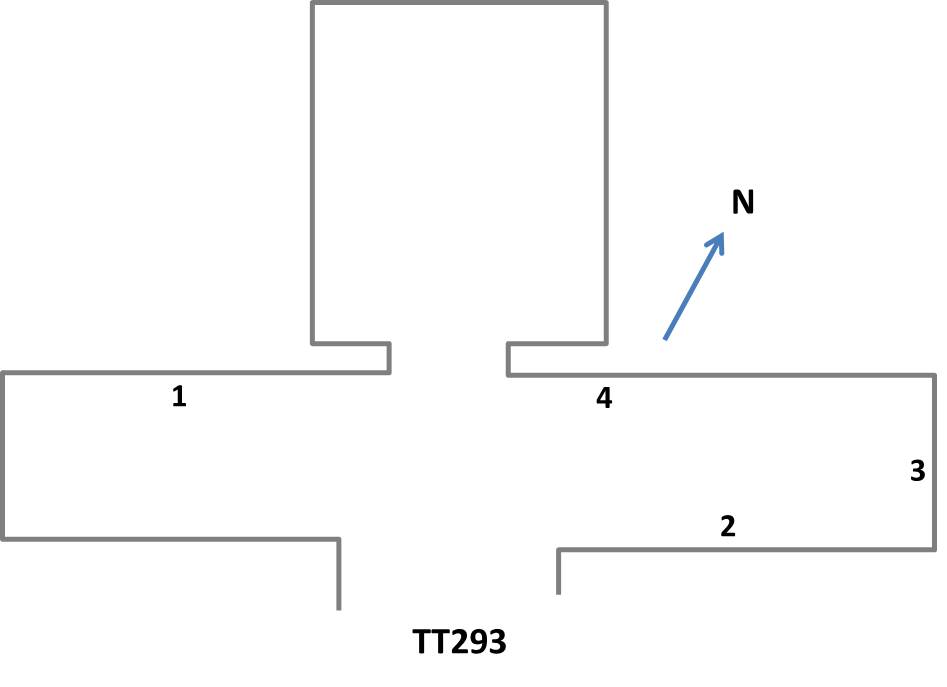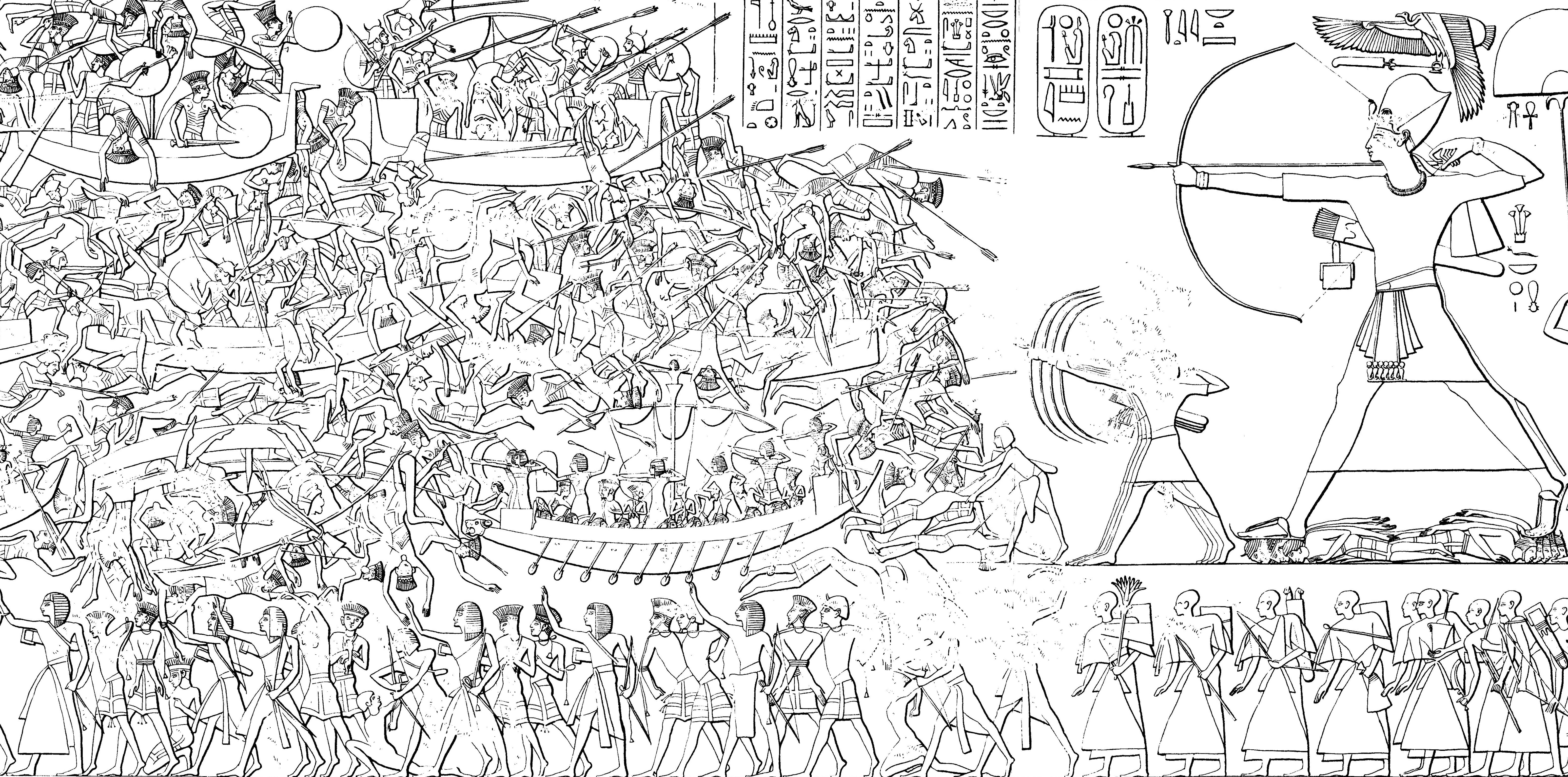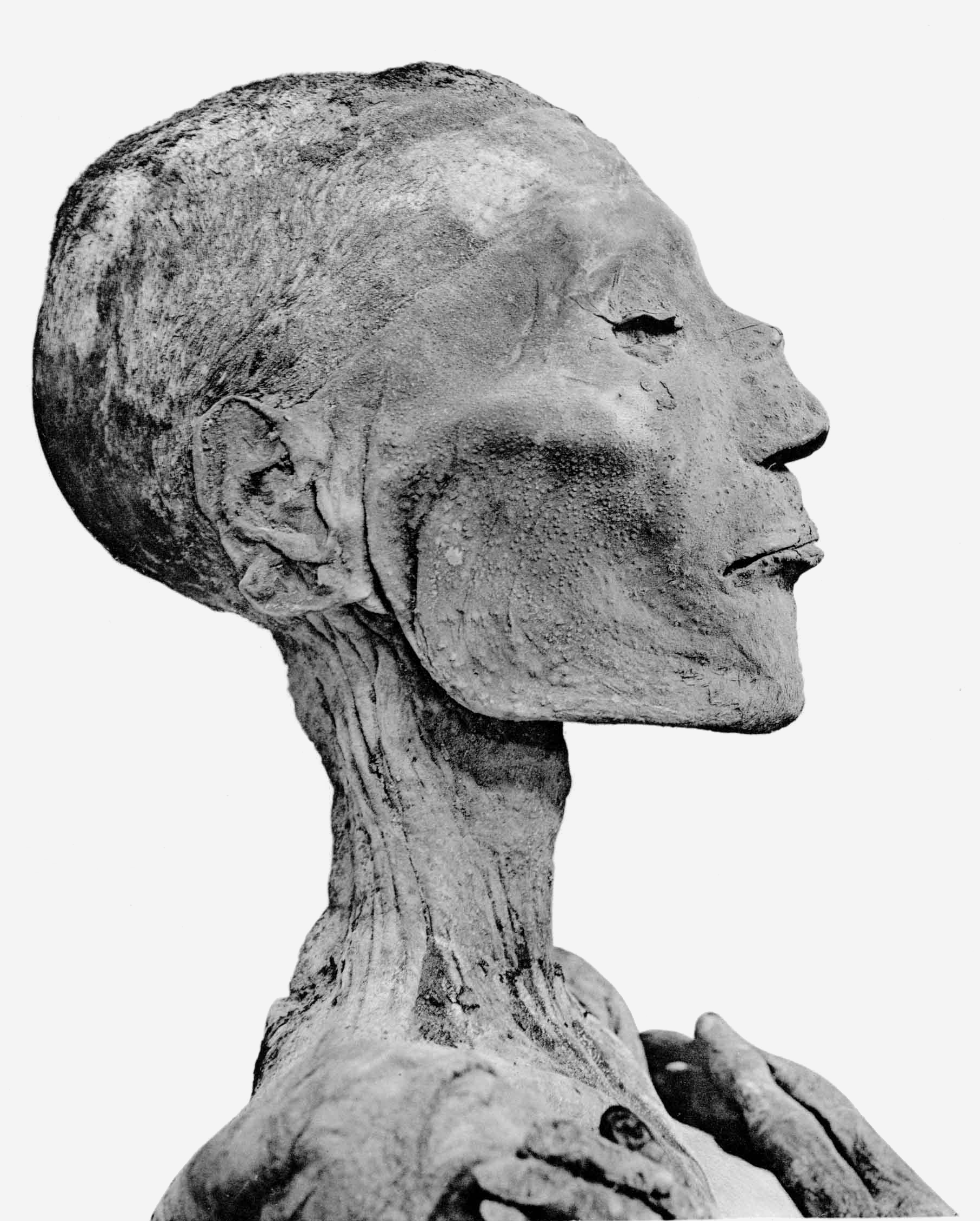|
Ramessesnakht
Ramessesnakht was High Priest of Amun during many years in the 20th Dynasty. He was appointed as the High Priest at Thebes under Ramesses IV. He served in office until the reign of Ramesses IX. It was during Ramessesnakht's tenure that the power and importance of the Amun priesthood grew over Egypt while the Pharaoh's power began to noticeably decline. Biography He was the son of Meribastet, steward to the pharaoh. Ramessesnakht was married to Adjedet-Aat, the daughter of Setau, High Priest of Nekhbet, and had at least two sons: Amenhotep and Nesamun and a daughter Tamerit. His son Amenhotep would succeed him in office and there is evidence that, at least for a while, his son, the Second Prophet of Amun Nesamun also acted as High Priest of Amun. His daughter Tamerit married Amenemopet, Third Prophet of Amun, making the family related through marriage to another important priestly family, that of Bakenkhonsu who served as High Priest of Amun under Ramesses II. (Amenemopet w ... [...More Info...] [...Related Items...] OR: [Wikipedia] [Google] [Baidu] |
Ramesses VI
Ramesses VI Nebmaatre-Meryamun (sometimes written Ramses or Rameses, also known under his princely name of Amenherkhepshef C) was the fifth ruler of the Twentieth Dynasty of Egypt. He reigned for about eight years in the mid-to-late 12th century BC and was a son of Ramesses III and queen Iset Ta-Hemdjert. As a prince, he was known as Ramesses Amunherkhepeshef and held the titles of royal scribe and cavalry general. He was succeeded by his son, Ramesses VII, Ramesses VII Itamun, whom he had fathered with queen Nubkhesbed. After the death of the ruling pharaoh, Ramesses V, who was the son of Ramesses VI's older brother, Ramesses IV, Ramesses VI ascended the throne. In the first two years after his Coronation of the pharaoh, coronation, Ramesses VI stopped frequent raids by Libyan or Egyptian marauders in Upper Egypt and buried his predecessor in what is now an unknown tomb of the Theban necropolis. Ramesses VI usurped KV9, a tomb in the Valley of the Kings planned by and for Rames ... [...More Info...] [...Related Items...] OR: [Wikipedia] [Google] [Baidu] |
Amenhotep (High Priest Of Amun)
Amenhotep was the High Priest of Amun towards the end of the Twentieth Dynasty of Egypt, serving under Ramesses IX, Ramesses X and Ramesses XI. He was the son of Ramessesnakht, the previous high priest of Amun. It is not beyond dispute who succeeded him in office. For a long time it was assumed that he was followed by the High Priest Herihor. However, Karl Jansen-Winkeln has suggested that Amenhotep was instead succeeded by the High Priest Piankh. We know the names of several of his brothers and a sister: * his (eldest?) brother, the prophet of Amun Meribast II * his brother, the Chief Steward Usimarenakth II * his sister Aatmeret I * his brother, the Second Prophet of Amun Nesamun I (see below) The "Transgression against the High Priest" From several references in the Tomb Robbery Papyri ( Pap. Mayer A; Pap. B.M. 10383; Pap. B.M. 10052) it can be deduced that, sometime prior to the start of the era known as the Wehem Mesut, the Viceroy of Kush Pinehesy attacked Thebes and re ... [...More Info...] [...Related Items...] OR: [Wikipedia] [Google] [Baidu] |
Theban High Priests Of Amun
The High Priest of Amun or First Prophet of Amun (''wikt:ḥm#Egyptian, ḥm wikt:nṯr#Egyptian, nṯr wikt:tpj#Egyptian, tpj n wikt:jmn#Egyptian, jmn'') was the highest-ranking priest in the priesthood of the ancient Egyptian deities, ancient Egyptian god Amun. The first high priests of Amun appear in the New Kingdom of Egypt, at the beginning of the Eighteenth Dynasty of Egypt, Eighteenth Dynasty. History The priesthood of Amun rose in power during the early Eighteenth dynasty through significant tributes to the god Amun by rulers such as Hatshepsut and more importantly Thutmose III. The Amun priesthood in Thebes had four high-ranking priests: * The Chief Prophet of Amun at Karnak (''ḥm nṯr tpj n jmn''), also referred to as the Chief Priest of Amun. * The Second Prophet of Amun at Karnak (''ḥm nṯr snnw n jmn''), also referred to as the Second Priest of Amun. * The Third Prophet of Amun at Karnak (''ḥm nṯr ḫmtnw n jmn khemet-nu''), also referred to as the Third Pri ... [...More Info...] [...Related Items...] OR: [Wikipedia] [Google] [Baidu] |
Ramesses X
Khepermaatre Ramesses X (also written Ramses and Rameses) (ruled ) was the ninth pharaoh of the 20th Dynasty of Ancient Egypt. His birth name was Amonhirkhepeshef. His prenomen or throne name, Khepermaatre, means "The Justice of Re Abides." Reign His accession day fell on 1 ''prt'' 27 (first month of the Winter season, day 27). His highest attested regnal year is year 3; the highest attested date in his reign is either "year 3, second month of the Inundation season, day 2" or possibly "year 3, month 4 (no day given)". However, a later 20th Dynasty papyrus fragment from Deir el-Medina published in 2023 by Egyptologist Robert Demarée refers to a partial date of Year 4, third month of Inundation r Akhettogether with a change to Year 1, month 4 of Inundation. Although both kings are unnamed, it is strongly suggested by Demarée to refer to the reigns of Ramesses X and his successor Ramesses XI. If confirmed, this would mean that Ramesses X ruled for 3 years and 10 months or nearly ... [...More Info...] [...Related Items...] OR: [Wikipedia] [Google] [Baidu] |
Bakenkhonsu
Bakenkhonsu ("Servant of Khonsu") was a High Priest of Amun in ancient Egypt during the reign of Pharaoh Ramesses II.Dodson, Aidan (2001). ''The Hieroglyphs of Ancient Egypt''. New York: Barnes & Noble. Hardcover: , p. 30. Information about his life was found on the back of his block statue (which is now located in Munich). The information on the statue provides details about the education of young Egyptian noblemen at that time and the career of priests. Bakenkhonsu is named for the god Khon su, ''traveller,'' a Moon God of ancient Egypt and son of Amun. Life According to the information inscribed on his statue, Bakenkhonsu was the son of Ipui, a priest of Amun (other sources suggest that he was the son of Roma, whose wife was also called Roma). His two younger brothers were Roma-Roi and Ipui. He spent four years at school, starting at the age of four, as was customary at that time. He then worked at the stables of Pharaoh Seti I for eleven years. There he learned to sho ... [...More Info...] [...Related Items...] OR: [Wikipedia] [Google] [Baidu] |
High Priest Of Amun
The High Priest of Amun or First Prophet of Amun ('' ḥm nṯr tpj n jmn'') was the highest-ranking priest in the priesthood of the ancient Egyptian god Amun. The first high priests of Amun appear in the New Kingdom of Egypt, at the beginning of the Eighteenth Dynasty. History The priesthood of Amun rose in power during the early Eighteenth dynasty through significant tributes to the god Amun by rulers such as Hatshepsut and more importantly Thutmose III. The Amun priesthood in Thebes had four high-ranking priests: * The Chief Prophet of Amun at Karnak (''ḥm nṯr tpj n jmn''), also referred to as the Chief Priest of Amun. * The Second Prophet of Amun at Karnak (''ḥm nṯr snnw n jmn''), also referred to as the Second Priest of Amun. * The Third Prophet of Amun at Karnak (''ḥm nṯr ḫmtnw n jmn khemet-nu''), also referred to as the Third Priest of Amun. * The Fourth Prophet of Amun at Karnak (''ḥm nṯr jfdw n jmn''), also referred to as the Fourth Priest of Amun. ... [...More Info...] [...Related Items...] OR: [Wikipedia] [Google] [Baidu] |
Twentieth Dynasty Of Egypt
The Twentieth Dynasty of Egypt (notated Dynasty XX, alternatively 20th Dynasty or Dynasty 20) is the third and last dynasty of the Ancient Egyptian New Kingdom period, lasting from 1189 BC to 1077 BC. The 19th and 20th Dynasties together constitute an era known as the Ramesside period owing to the predominance of rulers with the given name "Ramesses". This dynasty is generally considered to mark the beginning of the decline of Ancient Egypt at the transition from the Late Bronze to Iron Age. During the period of the Twentieth Dynasty, Ancient Egypt faced the crisis of invasions by Sea Peoples. The dynasty successfully defended Egypt, while sustaining heavy damage. History After the death of the last pharaoh of the 19th Dynasty, Queen Twosret, Egypt entered into a period of civil war. Because of lost historical records, the cause of the civil war is unknown. The war was ended with the accession to the throne by Setnakhte, who founded the 20th Dynasty of Egypt. From the reign ... [...More Info...] [...Related Items...] OR: [Wikipedia] [Google] [Baidu] |
Ramesses IV
Usermaatre Heqamaatre Setepenamun Ramesses IV (also written Ramses or Rameses) was the third pharaoh of the Twentieth Dynasty of the New Kingdom of Ancient Egypt. He was the second son of Ramesses III and became crown prince when his elder brother Amenherkhepshef died aged 15Peden, A. J., The Reign of Ramesses IV, Aris & Phillips Ltd, (1994). in 1164 BC, when Ramesses was only 12 years old. His promotion to crown prince: is suggested by his appearance (suitably entitled) in a scene of the festival of Min at the Ramesses III temple at Karnak, which may have been completed by Year 22 f his father's reign (the date is mentioned in the poem inscribed there) As his father's chosen successor, the prince employed three distinctive titles: "Hereditary Prince", "Royal scribe" and "Generalissimo." The latter two titles are mentioned in a text at the temple of Amenhotep III at Soleb and all three titles appear on a lintel now in Florence, Italy. As heir-apparent he took on increasin ... [...More Info...] [...Related Items...] OR: [Wikipedia] [Google] [Baidu] |
Ramesses V
Usermaatre Sekheperenre Ramesses V (also written Ramses and Rameses) was the fourth pharaoh of the Twentieth Dynasty of Egypt and was the son of Ramesses IV and Duatentopet. His mummy is now on display at the National Museum of Egyptian Civilization in Cairo. Reign Ramesses V's reign was characterized by the continued growth of the power of the priesthood of Amun, which controlled much of the temple land in the country and the state finances, at the expense of the ruling pharaohs. The Turin 1887 papyrus records a financial scandal during Ramesses' reign that involved the priests of Elephantine. Year 1 A period of domestic instability also afflicted his reign, as evidenced by the fact that, according to the Turin Papyrus Cat. 2044, the workmen of Deir el-Medina periodically stopped work on Ramesses V's KV9 tomb in this king's first regnal year, out of fear of "''the enemy''", presumably Libyan raiding parties, who had reached the town of Per-Nebyt and "''burnt its people''." ... [...More Info...] [...Related Items...] OR: [Wikipedia] [Google] [Baidu] |
Richard Anthony Parker
Richard Anthony Parker (December 10, 1905 – June 3, 1993) was a prominent Egyptologist and professor of Egyptology. Originally from Chicago, he attended Mt. Carmel High School (then known as St. Cyril) with acclaimed author James T. Farrell. He received an A.B. from Dartmouth College in 1930, and a Ph.D. in Egyptology from the University of Chicago in 1938. He then went to Luxor, Egypt to work as an epigrapher with the University of Chicago's Epigraphic and Architectural Survey, studying the mortuary temple of Ramses III. When World War II necessitated a temporary halt to the project, Parker came back to Chicago to teach Egyptology at the university. In 1946, he returned to Egypt to continue his work on the epigraphic survey, and soon rose to the position of field director. In 1948, he founded the Department of Egyptology at Brown University and became its first chairman, and also assumed the newly created position of the Charles Edwin Wilbour Professorship. That year, Parker a ... [...More Info...] [...Related Items...] OR: [Wikipedia] [Google] [Baidu] |
Journal Of Egyptian Archaeology
The ''Journal of Egyptian Archaeology (JEA)'' is a bi-annual Peer review, peer-reviewed international academic journal published by the Egypt Exploration Society. Covering Egyptology, Egyptological research, the JEA publishes scholarly articles, fieldwork reports, and reviews of books on Egyptology. Articles are mainly published in English, with contributions in German language, German or French language, French accepted where suitable. The JEA was established in 1914 by the Egypt Exploration Society, Egypt Exploration Fund. Its editors have included several prominent Egyptologists, including Alan Gardiner (1916–21, 1934, 1941–46); T. Eric Peet (1923–1934) and Battiscombe Gunn (1935–1939). The current (2021) editor-in-chief is of University College London. (Access date 9 May 2021) References External links * Searchable index of article titles 1914~2022 (use JEA as abbr. for journal) via University of Toronto Academic journals published by learned and profess ... [...More Info...] [...Related Items...] OR: [Wikipedia] [Google] [Baidu] |
TT293
TT, Tt, tt, or .tt may refer to: Arts and entertainment Gaming * ''Manx TT Super Bike'', an arcade racing game by Sega * ''Tourist Trophy'' (video game), a motorcycle racing game for the PlayStation 2 * T.T., a character in ''Diddy Kong Racing'' Music * "TT" (song), a song by Twice * Tritone, the musical interval of an augmented fourth or diminished fifth * Theresa Wayman (born 1980), American musician, stage name TT * Tying Tiffany (born 1978), Italian singer, stage name TT Other arts and entertainment * ''The Dominators'' (production code: TT), a 1968 ''Doctor Who'' serial * T.T., a fictional character in the film ''The Forever Purge'' * Thomas Thorpe (T.T.), the publisher of Shakespeare's sonnets Business and organizations * TT Electronics, a British maker of automotive components * Tom Tailor, a German clothing company * TT Games, a British software producer * TT News Agency, a Swedish news agency * TT Technologies, a construction equipment manufacturer * ThunderTalk Ga ... [...More Info...] [...Related Items...] OR: [Wikipedia] [Google] [Baidu] |







